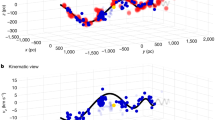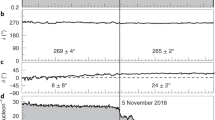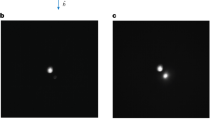Abstract
ONE of the most intriguing discoveries of the Ulysses mission so far has been the detection of periodic, collimated streams of high-velocity, submicrometre-sized dust particles emanating from Jupiter1,2. To explain the Ulysses data, Horanyi et al. showed3 that electromagnetic forces within Jupiter's magnetosphere can accelerate and eject small dust particles; they proposed a model in which Io is the source of the dust, and the observed periodicity arises from a resonance between the orbital and rotational periods of Io and Jupiter respectively. Here we argue that the masses and velocities of the detected particles are better explained by an origin in Jupiter's gossamer ring. Following their ejection from the magnetosphere, the dust particles are accelerated by the interplanetary magnetic field (IMF). We find that it is the temporal evolution of the IMF which primarily determines the particle trajectories, and hence which particles reach the spacecraft. Our model explains three main features observed in the Ulysses data: fewer streams are detected before closest approach than after, the observed periodicity is closely related to the solar rotation period, and an extremely intense dust stream is detected immediately after closest approach.
This is a preview of subscription content, access via your institution
Access options
Subscribe to this journal
Receive 51 print issues and online access
$199.00 per year
only $3.90 per issue
Buy this article
- Purchase on SpringerLink
- Instant access to full article PDF
Prices may be subject to local taxes which are calculated during checkout
Similar content being viewed by others
References
Grün, E. et al. Science 257, 1550–1552 (1992).
Grün, E. et al. Nature 362, 428–430 (1993).
Horanyi, M., Morfill, G. & Grün, E. Nature 363, 144–146 (1993).
Burns, J. A. & Schaffer, L. E. Nature 337, 340–343 (1989).
Hamilton, D. P. Icarus 101, 244–264 (1993).
Schaffer, L. E. thesis Cornell Univ. (1989).
Horanyi, M. & Burns, J. A. J. geophys. Res. 96, 19283–19289 (1991).
Horanyi, M., Morfill, G. & Grün, E. J. geophys. Res. (submitted).
Showalter, M. R., Burns, J. A., Cuzzi, J. N. & Pollack J. B. Icarus 69, 458–498 (1987).
Showalter, M. R., Burns, J. A., Cuzzi, J. N. & Pollack, J. B. Nature 316, 526–528 (1985).
Johnson, T. V., Morfill, G. & Grün, E. Geophys. Res. Lett. 7, 305–308 (1980).
Burns, J. A., Showalter, M. R. & Morfill, G. E. in Planetary Rings (eds Greenberg, R. & Brahic, A.) 200–272 (Univ. of Arizona, Tucson, 1984).
Schaffer, L. E. & Burns, J. A. J. geophys. Res. (submitted).
Grün, E. et al. Space Sci. Rev. 60, 317–340 (1992).
Grün, E. et al. Astr. Astropbys. Suppl. Ser. 92, 411–423 (1992).
Fìsk, L. A. in The Ancient Sun (eds Pepin, R. O., Eddy, J. A. & Merill, R. B.) 103–118 (Pergamon, New York, 1980).
Smith, E. J. in The Sun in Time (eds Sonett, C. P., Giampapa, M. S. & Matthews, M. S.) 175–201 (Univ. of Arizona, Tucson, 1991).
Smith, E. J., Slavin, J. A. & Thomas, B. T. in The Sun and the Heliosphere in Three Dimensions (ed. Marsden, R. G.) 267–274 (Reidel, Dordrecht, 1986).
Author information
Authors and Affiliations
Rights and permissions
About this article
Cite this article
Hamilton, D., Burns, J. Ejection of dust from Jupiter's gossamer ring. Nature 364, 695–699 (1993). https://doi.org/10.1038/364695a0
Received:
Accepted:
Issue Date:
DOI: https://doi.org/10.1038/364695a0
This article is cited by
-
Dust in the Jupiter system outside the rings
Astrodynamics (2019)
-
Dust Emission by Active Moons
Space Science Reviews (2018)
-
The sculpting of Jupiter’s gossamer rings by its shadow
Nature (2008)
-
High-velocity streams of dust originating from Saturn
Nature (2005)
-
The Cassini Cosmic Dust Analyzer
Space Science Reviews (2004)
Comments
By submitting a comment you agree to abide by our Terms and Community Guidelines. If you find something abusive or that does not comply with our terms or guidelines please flag it as inappropriate.



